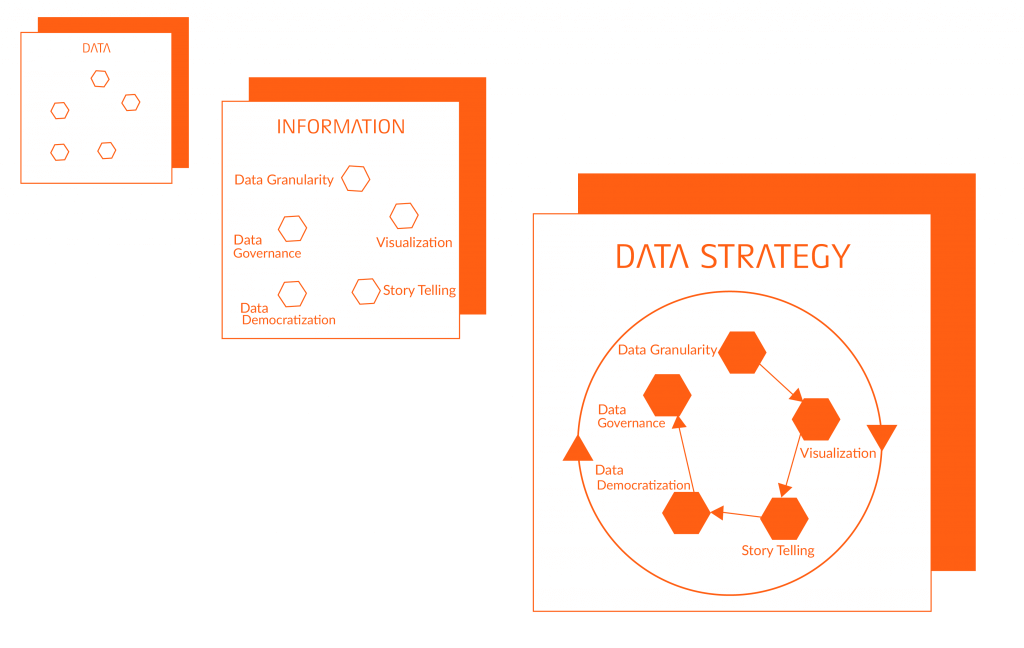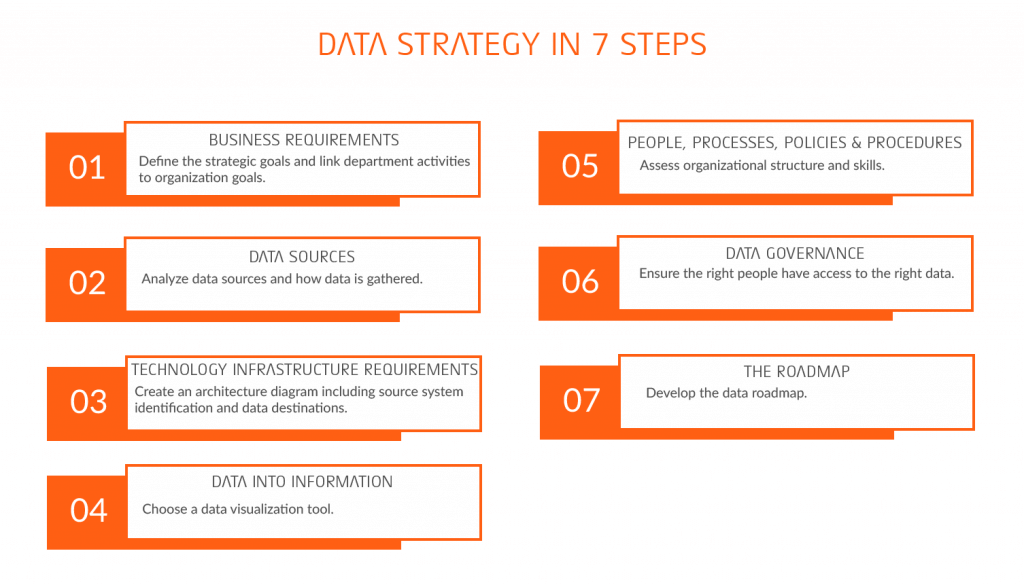Importance of Data Strategy
Companies are learning their data is a strategic asset. It can be used to make smarter decisions but there is a problem – data is complicated.
Data is often in scattered source systems, and the source systems do not communicate with one another. Data quality can be a problem. The time and money to fix these long-term problems can be significant.
Many companies prioritize urgent, tactical, day-to-day needs above long-term strategic initiatives.
Begin with a Data Strategy
A data-driven corporate culture is possible, and it starts with your Data Strategy.
A Data Strategy is usually thought of as technical process – however a comprehensive Data Strategy addresses far more than just the data. It defines People, Process, Policies, Procedures, and Technology.
What is needed?
1. Employees empowered to use the data.
2. Processes to improve data quality and allow employee access.
3. Technology which enables this.
A Data Strategy creates a plan to improve analytic abilities. It focuses on the transition from decisions based on what has happened to making predictive decisions.
As shown in the Gartner Analytic Ascendancy Model (below) the goal is to move:
– from Descriptive Analytics (What happened?)
– to Prescriptive Analytics (How can we make it happen?)
Gartner Analytic Ascendancy Model

Ingredients of a Data Strategy
iRangers have helped companies with varying levels of analytical maturity and technical needs craft their Data Strategy. Each of the following elements have been identified through this experience and can be applied to any organization looking to get ahead with their data.
1. Business Requirements
Business needs and goals drive the data priorities and generate value.
The first step of defining the business requirements is to identify a sponsor (or champion), and subject matter experts (SME) in the organization. The sponsor of the Data Strategy is the executive who will lead the initiative. Other SMEs are leaders (technical or management) representing specific company departments.
The second step is to define the strategic goals and link department activities to organization goals. Goals will exist at both the company and department level – but the goals for both need to be synchronized.
These objectives are most effectively gathered through an interview process that starts at the executive level and continues down to departments leaders. Through this process, we will discover what leaders are trying to measure, what they are trying to improve, questions they want answered, and ultimately, the key performance indicators (KPI) to answer those questions.
By starting with the gathering and documenting the business requirements, we overcome the first roadblock to many IT or technical projects: knowledge of what the business is trying to accomplish.
2. Data Sources
With a good understanding of what questions the business is asking we can turn to the next element: analyzing data sources, and how the data is gathered. It is unlikely that all data will be available within the organization and that it already exists in a place that is accessible. So, we need to work backwards to find the source.
For data that can be found in-house, we note the source system and any roadblocks to getting assess (for example, data privacy). We also need to determine whether the data has the right level of detail and is updated with the right frequency to answer the question effectively.
3. Technology Infrastructure Requirements
Focus on the business reasons for your initiatives. Building a flexible and scalable data architecture is a complex topic for which there are many options and approaches, so here are important things to consider:
1. To what extent can an operational system support analytics needs? Likely very little. It is generally not best practice to rely on an operational system to meet analytical needs which means a central data repository is needed.
2. Does the organization have the skills and technical infrastructure to support a data warehouse on-prem, or would leveraging a cloud-based solution make more sense?
3. Where the data does not exist today, how will the gaps be filled? Can the data be calculated or estimated? Can it be purchased from third-party market trend data or macro-economic data? Or can a new source system be implemented to generate the data?
4. Is there a standard integration tool to get the data from source systems into the central repository? Will this layer of the architecture be leveraged for business logic so the data is ready to be used?
5. How will you provide or provision access? Will IT create reports, or will you enable self-service? Will the reports be pixel perfect (printable) reports, or will the reports allow user interaction with the data? Will they be embedded into websites and provided to people outside the network?
These considerations will help develop an overall architecture. The more requirements and future needs are considered, the more the solution will support the business.
An architecture diagram will identify and represent all the source systems, the methods to ingest data and the destinations (data marts, data lakes and data warehouses). It will also layer in processes like data governance and information security.
4. Data into Information
A Data Strategy provides recommendations how to apply analytics to extract business-critical insights. Data visualizations make this possible. Many companies still rely on Excel, email, or a legacy BI tool that does not allow interaction with the data. Often a tedious, manual process is required, and relying on IT to create visualizations becomes a bottleneck.
Data visualization tools should make the data look good, but more importantly, make it easier to understand and interpret.
Factors to consider for choosing a data visualization tool are:
Data Granularity – Be able to provide right level of detail for the right audience. An analyst may need more detailed information than an executive, and some people may need drill-down capabilities.
Visualizations – Quickly spot trends and outliers and avoid introducing confusion.
Story Telling – Presents context of metrics and anticipate the user path of problem investigation.
Data Democratization – Who has access to what data? Encourage sharing and wide-spread adoption and define common definitions and metrics across the organization.
Data Governance – Implement procedures, processes, policies, and practices to help ensure the formal management of data assets.

5. People Processes Policies and Procedures
As we have stated, becoming data driven requires more than just technology. In this stage we look at the people in the organization and the processes related to creating, sharing, and governing data.
A Data Strategy is likely going to introduce more data, data analysis, and new tools. Based on this, it makes sense to look at the skillsets of the users to understand their strengths and where they will need support. Do they need training? Do you need to hire more people? Organizational structure should also be assessed – should analysts be aligned to a business unit or to IT? And how IT will support the business in their analytics needs? Even topics like employee reviews and incentive plans should be evaluated. After all, these can be used levers to encourage employees to use data in the way the organization is intending.
When it comes to process, many organizations have unintentional roadblocks to utilizing their data in decision making. Business processes may need to be re-engineered to incorporate data analysis. This can be achieved by documenting the steps in a process and where specific reports are leveraged for a decision. We can also mandate that specific data be provided as rationale for a business decision. Recognition can also go a long way – when you gain a win that is based on new use of data, it should be celebrated and promoted to build internal momentum and encourage positive behaviors with data.
6. Data Governance
Data Governance is what ultimately allows enterprise level sharing of data and the oil that lubricates the machinery of an analytics practice.
A data governance program will ensure that:
– Calculations used across the enterprise are determined based on input from across the enterprise.
– The right people have access to the right data.
– Data lineage (where did the data originate and how was it transformed since that origination) is defined.
We don’t look to a tool to solve data governance; it is people work. Data Governance takes leadership and sometimes navigating through difficult conversations.
Developing a data dictionary is a good place to start. A data dictionary is a living document in which all available end-user measures and dimensions are formally defined. During these conversations, misunderstandings about terms are identified and corrected.
7. The Roadmap
The Roadmap is the culmination of all the work we have done to this point and what makes all our previous work actionable. We’ve identified all that needs to happen to bring you from where you are to where you’d like to go, but before getting started with any design, build, training, or re-engineering of a business process, it’s critical to prioritize the activities.
For each recommendation that will help bridge the gap from current state to the future state, define the feasibility and expected business value it will provide. The plan should prioritize activities that are easiest to implement but also provide quick wins to the business.
Other factors to include in the roadmap are:
– Staff availability and whether outside help is required.
– A company’s budgeting process, specifically if a capital investment is required.
– Competing projects that might prevent the right resources from participating.
– A timeline that allows for recognition of incremental wins that are earned along the way.

Conclusion
Data is complicated. It is also important. It is strategic asset that when planned, directed, and managed well, can be the backbone of business improvement and positive outcomes – including enhanced business profitability.
Your company can make smarter decisions, but before that happens, you need to begin the data strategy journey.
Do not give in to the urgency of day-to-day needs above long-term strategic initiatives. Think long-term and develop your data strategy over time, focusing the business on what is truly important.
If you’d like further information, please email us at info@iRangers.com or message us here.


